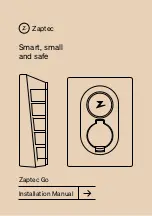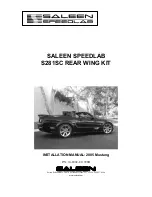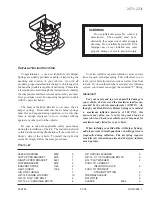
INTAKE MANIFOLD AIR TEMPERATURE
SENSOR—PCM INPUT
DESCRIPTION
The 2–wire Intake Manifold Air Temperature (IAT)
sensor is installed in the intake manifold with the
sensor element extending into the air stream.
The IAT sensor is a two-wire Negative Thermal
Coefficient (NTC) sensor. Meaning, as intake mani-
fold temperature increases, resistance (voltage) in the
sensor decreases. As temperature decreases, resis-
tance (voltage) in the sensor increases.
OPERATION
The IAT sensor provides an input voltage to the
Powertrain Control Module (PCM) indicating the
density of the air entering the intake manifold based
upon intake manifold temperature. At key-on, a
5–volt power circuit is supplied to the sensor from
the PCM. The sensor is grounded at the PCM
through a low-noise, sensor-return circuit.
The PCM uses this input to calculate the following:
•
Injector pulse-width
•
Adjustment of spark timing (to help prevent
spark knock with high intake manifold air-charge
temperatures)
The resistance values of the IAT sensor is the same
as for the Engine Coolant Temperature (ECT) sensor.
MANIFOLD ABSOLUTE PRESSURE (MAP)
SENSOR—PCM INPUT
DESCRIPTION
The Manifold Absolute Pressure (MAP) sensor is
attached to the side of the engine throttle body with
2 screws. The sensor is connected to the throttle body
with a rubber L-shaped fitting.
OPERATION
The MAP sensor is used as an input to the Power-
train Control Module (PCM). It contains a silicon
based sensing unit to provide data on the manifold
vacuum that draws the air/fuel mixture into the com-
bustion chamber. The PCM requires this information
to determine injector pulse width and spark advance.
When manifold absolute pressure (MAP) equals
Barometric pressure, the pulse width will be at max-
imum.
A 5 volt reference is supplied from the PCM and
returns a voltage signal to the PCM that reflects
manifold pressure. The zero pressure reading is 0.5V
and full scale is 4.5V. For a pressure swing of 0–15
psi, the voltage changes 4.0V. To operate the sensor,
it is supplied a regulated 4.8 to 5.1 volts. Ground is
provided through the low-noise, sensor return circuit
at the PCM.
The MAP sensor input is the number one contrib-
utor to fuel injector pulse width. The most important
function of the MAP sensor is to determine baromet-
ric pressure. The PCM needs to know if the vehicle is
at sea level or at a higher altitude, because the air
density changes with altitude. It will also help to cor-
rect for varying barometric pressure. Barometric
pressure and altitude have a direct inverse correla-
tion; as altitude goes up, barometric goes down. At
key-on, the PCM powers up and looks at MAP volt-
age, and based upon the voltage it sees, it knows the
current barometric pressure (relative to altitude).
Once the engine starts, the PCM looks at the voltage
again, continuously every 12 milliseconds, and com-
pares the current voltage to what it was at key-on.
The difference between current voltage and what it
was at key-on, is manifold vacuum.
During key-on (engine not running) the sensor
reads (updates) barometric pressure. A normal range
can be obtained by monitoring a known good sensor.
As the altitude increases, the air becomes thinner
(less oxygen). If a vehicle is started and driven to a
very different altitude than where it was at key-on,
the barometric pressure needs to be updated. Any
time the PCM sees Wide Open Throttle (WOT), based
upon Throttle Position Sensor (TPS) angle and RPM,
it will update barometric pressure in the MAP mem-
ory cell. With periodic updates, the PCM can make
its calculations more effectively.
The PCM uses the MAP sensor input to aid in cal-
culating the following:
•
Manifold pressure
•
Barometric pressure
•
Engine load
•
Injector pulse-width
•
Spark-advance programs
•
Shift-point strategies (certain automatic trans-
missions only)
•
Idle speed
•
Decel fuel shutoff
The MAP sensor signal is provided from a single
piezoresistive element located in the center of a dia-
phragm. The element and diaphragm are both made
of silicone. As manifold pressure changes, the dia-
phragm moves causing the element to deflect, which
stresses the silicone. When silicone is exposed to
stress, its resistance changes. As manifold vacuum
increases, the MAP sensor input voltage decreases
proportionally. The sensor also contains electronics
that condition the signal and provide temperature
compensation.
The PCM recognizes a decrease in manifold pres-
sure by monitoring a decrease in voltage from the
reading stored in the barometric pressure memory
cell. The MAP sensor is a linear sensor; meaning as
pressure changes, voltage changes proportionately.
14 - 32
FUEL SYSTEM
XJ
DESCRIPTION AND OPERATION (Continued)
Summary of Contents for 200 Cherokee
Page 5: ...FASTENER IDENTIFICATION 4 INTRODUCTION XJ DESCRIPTION AND OPERATION Continued ...
Page 6: ...FASTENER STRENGTH XJ INTRODUCTION 5 DESCRIPTION AND OPERATION Continued ...
Page 8: ...METRIC CONVERSION CHART XJ INTRODUCTION 7 DESCRIPTION AND OPERATION Continued ...
Page 9: ...TORQUE SPECIFICATIONS 8 INTRODUCTION XJ DESCRIPTION AND OPERATION Continued ...
Page 47: ......
Page 107: ...Fig 105 Gear Tooth Contact Patterns 3 60 TUBE 181 AND 186 FBI AXLE XJ ADJUSTMENTS Continued ...
Page 111: ...Installer D 144 Installer W 262 3 64 TUBE 181 AND 186 FBI AXLE XJ SPECIAL TOOLS Continued ...
Page 145: ...Fig 79 Gear Tooth Contact Patterns 3 98 194 RBI AXLE XJ ADJUSTMENTS Continued ...
Page 177: ...Fig 59 Gear Tooth Contact Patterns 3 130 8 1 4 REAR AXLE XJ ADJUSTMENTS Continued ...
Page 230: ...Fig 8 Clutch Components And Inspection XJ CLUTCH 6 5 DIAGNOSIS AND TESTING Continued ...
Page 241: ......
Page 357: ......
Page 367: ......
Page 449: ......
Page 451: ......
Page 475: ......
Page 484: ...SPECIAL TOOLS HEADLAMP ALIGNMENT Headlamp Aiming Kit C 4466 A XJ LAMPS 8L 9 ...
Page 507: ......
Page 537: ......
Page 551: ......
Page 571: ......
Page 577: ......
Page 583: ......
Page 613: ......
Page 615: ......
Page 631: ......
Page 669: ......
Page 707: ......
Page 735: ......
Page 783: ......
Page 789: ......
Page 805: ......
Page 823: ......
Page 827: ......
Page 851: ......
Page 863: ......
Page 867: ......
Page 893: ......
Page 921: ......
Page 925: ......
Page 931: ......
Page 937: ......
Page 1047: ......
Page 1072: ...Fig 16 2 5L Engine XJ 8W 90 CONNECTOR LOCATIONS 8W 90 25 DESCRIPTION AND OPERATION Continued ...
Page 1073: ...Fig 17 4 0L Engine 8W 90 26 8W 90 CONNECTOR LOCATIONS XJ DESCRIPTION AND OPERATION Continued ...
Page 1074: ...Fig 18 4 0L Engine XJ 8W 90 CONNECTOR LOCATIONS 8W 90 27 DESCRIPTION AND OPERATION Continued ...
Page 1087: ...Fig 31 Liftgate 8W 90 40 8W 90 CONNECTOR LOCATIONS XJ DESCRIPTION AND OPERATION Continued ...
Page 1099: ......
Page 1129: ......
Page 1249: ......
Page 1331: ...Fig 6 Frame Dimensions 13 8 FRAME AND BUMPERS XJ SPECIFICATIONS Continued ...
Page 1333: ......
Page 1335: ......
Page 1869: ......
Page 1875: ......
Page 1887: ......
Page 1912: ...Fig 3 Hood Components XJ BODY 23 25 REMOVAL AND INSTALLATION Continued ...
Page 1955: ...WELD LOCATIONS UPPER COWL 23 68 BODY XJ SPECIFICATIONS Continued ...
Page 1956: ...UPPER COWL XJ BODY 23 69 SPECIFICATIONS Continued ...
Page 1957: ...COWL 23 70 BODY XJ SPECIFICATIONS Continued ...
Page 1958: ...A PILLAR XJ BODY 23 71 SPECIFICATIONS Continued ...
Page 1959: ...A PILLAR 23 72 BODY XJ SPECIFICATIONS Continued ...
Page 1960: ...A PILLAR XJ BODY 23 73 SPECIFICATIONS Continued ...
Page 1961: ...A PILLAR 23 74 BODY XJ SPECIFICATIONS Continued ...
Page 1962: ...B PILLAR XJ BODY 23 75 SPECIFICATIONS Continued ...
Page 1963: ...D PILLAR 23 76 BODY XJ SPECIFICATIONS Continued ...
Page 1964: ...FUEL FILLER OPENING XJ BODY 23 77 SPECIFICATIONS Continued ...
Page 1965: ...CARGO AREA FLOOR PAN 23 78 BODY XJ SPECIFICATIONS Continued ...
Page 1966: ...ROOF AND D PILLAR XJ BODY 23 79 SPECIFICATIONS Continued ...
Page 1967: ...LIFTGATE OPENING 23 80 BODY XJ SPECIFICATIONS Continued ...
Page 1968: ...ROOF XJ BODY 23 81 SPECIFICATIONS Continued ...
Page 1969: ...ROOF 23 82 BODY XJ SPECIFICATIONS Continued ...
Page 1970: ...FRAME RAIL XJ BODY 23 83 SPECIFICATIONS Continued ...
Page 1971: ...FRAME RAIL 23 84 BODY XJ SPECIFICATIONS Continued ...
Page 1972: ...FRAME RAIL XJ BODY 23 85 SPECIFICATIONS Continued ...
Page 1973: ...FRAME RAIL 23 86 BODY XJ SPECIFICATIONS Continued ...
Page 1974: ...REINFORCEMENT XJ BODY 23 87 SPECIFICATIONS Continued ...
Page 1975: ...FRONT INNER FENDER 23 88 BODY XJ SPECIFICATIONS Continued ...
Page 1976: ...FRONT INNER FENDER AND RADIATOR CLOSURE PANEL XJ BODY 23 89 SPECIFICATIONS Continued ...
Page 1977: ...REINFORCEMENT 23 90 BODY XJ SPECIFICATIONS Continued ...
Page 1978: ...FRONT FENDER XJ BODY 23 91 SPECIFICATIONS Continued ...
Page 1979: ...BODY SIDE 23 92 BODY XJ SPECIFICATIONS Continued ...
Page 1980: ...REAR WHEELHOUSE XJ BODY 23 93 SPECIFICATIONS Continued ...
Page 1981: ...REAR INNER WHEELHOUSE 23 94 BODY XJ SPECIFICATIONS Continued ...
Page 1982: ...BODY SIDE XJ BODY 23 95 SPECIFICATIONS Continued ...
Page 1983: ...BODY SIDE 23 96 BODY XJ SPECIFICATIONS Continued ...
Page 1984: ...BODY SIDE XJ BODY 23 97 SPECIFICATIONS Continued ...
Page 1985: ...BODY SIDE 23 98 BODY XJ SPECIFICATIONS Continued ...
Page 1986: ...BODY SIDE XJ BODY 23 99 SPECIFICATIONS Continued ...
Page 1987: ...BODY SIDE 23 100 BODY XJ SPECIFICATIONS Continued ...
Page 1988: ...UNDERBODY XJ BODY 23 101 SPECIFICATIONS Continued ...
Page 1989: ...UNDERBODY 23 102 BODY XJ SPECIFICATIONS Continued ...
Page 1990: ...UNDERBODY XJ BODY 23 103 SPECIFICATIONS Continued ...
Page 1991: ...UNDERBODY 23 104 BODY XJ SPECIFICATIONS Continued ...
Page 1992: ...UNDERBODY XJ BODY 23 105 SPECIFICATIONS Continued ...
Page 1993: ...UNDERBODY 23 106 BODY XJ SPECIFICATIONS Continued ...
Page 1994: ...UNDERBODY XJ BODY 23 107 SPECIFICATIONS Continued ...
Page 1995: ...UNDERBODY 23 108 BODY XJ SPECIFICATIONS Continued ...
Page 1996: ...UNDERBODY XJ BODY 23 109 SPECIFICATIONS Continued ...
Page 1997: ...UNDERBODY 23 110 BODY XJ SPECIFICATIONS Continued ...
Page 1998: ...UNDERBODY XJ BODY 23 111 SPECIFICATIONS Continued ...
Page 1999: ...BODY SEALING LOCATIONS APPLICATION METHODS 23 112 BODY XJ SPECIFICATIONS Continued ...
Page 2000: ...COWL AND DASH PANEL XJ BODY 23 113 SPECIFICATIONS Continued ...
Page 2001: ...DASH PANEL AND FLOOR PAN 23 114 BODY XJ SPECIFICATIONS Continued ...
Page 2002: ...FLOOR PAN XJ BODY 23 115 SPECIFICATIONS Continued ...
Page 2003: ...REAR INNER WHEELHOUSE 23 116 BODY XJ SPECIFICATIONS Continued ...
Page 2004: ...FRONT INNER WHEELHOUSE XJ BODY 23 117 SPECIFICATIONS Continued ...
Page 2005: ...BODY SIDE 23 118 BODY XJ SPECIFICATIONS Continued ...
Page 2006: ...BODY SIDE XJ BODY 23 119 SPECIFICATIONS Continued ...
Page 2007: ...BODY SIDE 23 120 BODY XJ SPECIFICATIONS Continued ...
Page 2008: ...ROOF PANEL XJ BODY 23 121 SPECIFICATIONS Continued ...
Page 2009: ...FUEL FILLER HOUSING 23 122 BODY XJ SPECIFICATIONS Continued ...
Page 2010: ...LIFTGATE OPENING XJ BODY 23 123 SPECIFICATIONS Continued ...
Page 2011: ...STRUCTURAL ADHESIVE LOCATIONS LEFT QUARTER PANEL 23 124 BODY XJ SPECIFICATIONS Continued ...
Page 2012: ...REAR WHEELHOUSE XJ BODY 23 125 SPECIFICATIONS Continued ...
Page 2013: ...ROOF BOWS 23 126 BODY XJ SPECIFICATIONS Continued ...
Page 2023: ......
Page 2071: ......
















































